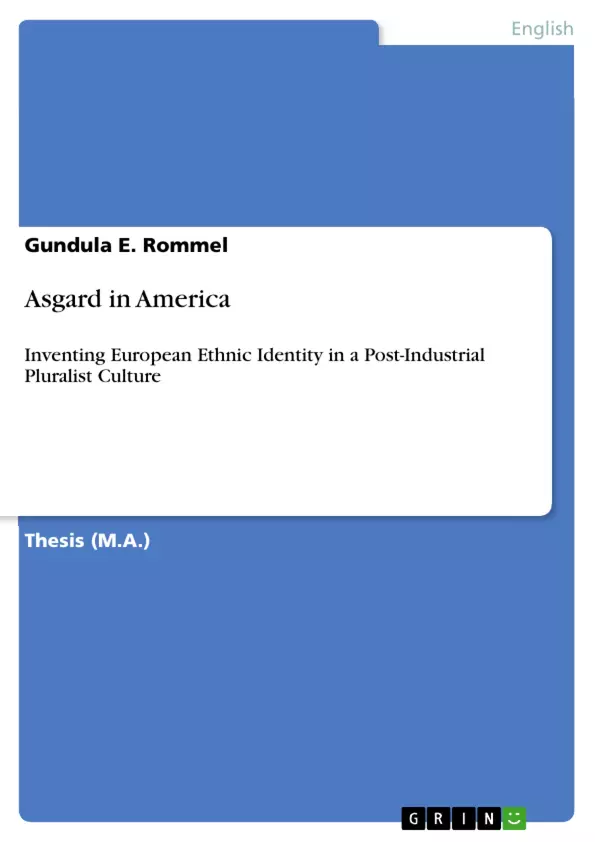Die vorliegende Arbeit untersucht die Konstruktion von Identität in den Diskursen dergermanisch-neuheidnischen Bewegung in den Vereinigten Staaten von Amerika. ErsteOrganisationen des Asatru, wie die Anhänger selbst ihre Religion nennen, entstanden in den siebziger Jahren und sind seitdem stetig angewachsen. Asatru versteht sich als die indigene Religion der Europäer, distanziert sich dementsprechend deutlich vor christlich geprägtenLeitkultur der amerikanischen Gesellschaft und erscheint dabei doch im Gegensatz zu den meisten anderen neuheidnischen Strömungen erstaunlich wertekonservativ. Asatru, so meine These, reagiert auf die Krise der Moderne und die daraus resultierende Krise westlicher Identität, indem es ebendiese Identität auf Grundlage einer diskursivenKonstruktion europäischer Ethnizität neu definiert. Die Notwendigkeit einer Neudefinierung euroamerikanischer Identität ergibt sich aus dem anwachsenden Druck, den die nicht-europäischen Minoritäten in ihren Bestrebungen zur Durchsetzung der eigenen kulturellen und politischen Interessen auf die vorherrschende europäisch geprägte Kultur in den Vereinigten Staaten ausüben. Da diese vorherrschende Kultur in der Tradition der europäischen Moderne steht, ist die von ihr gestiftete westliche Identität geprägt von Normen und Werten, die als absolut und universell gültig definiert sind. Daher ist die Erfahrung einer zunehmendpluralistischen Gesellschaft problematisch für die westliche Identität. Asatru scheint seinenAnhängern eine Lösung dieses Problems zu bieten.Um die Qualität dieser Lösung aufzuzeigen, werden nach einer allgemeinen Einführung zur amerikanischen Asatrubewegung zunächst der sich aus den pluralistischen Tendenzen in der amerikanischen Gesellschaft ergebende Kulturkonflikt sowie die Ursachen undAuswirkungen der Krise der Moderne aufgezeigt. Darauf folgt eine Diskursanalyse zurKonstruktion von Identität im Asatru. Der Schwerpunkt liegt dabei auf der Konstruktion von Ethnizität, welche jedoch vom religiösen Diskurs und der Konstruktion religiöser Identität nicht abzulösen ist. Integraler Bestandteil dieser ethnisch-religiösen Identität ist eine Ethik, die in groben Zügen ebenfalls untersucht wird. Abschließend widmet sich diese Arbeit der Frage nach der Einordnung der Asatru-Religion und der von ihr neudefinierten kulturellen Identität in die gegenwärtigen politisch-kulturellen Zusammenhänge der Amerikanischen Gesellschaft.
Inhaltsverzeichnis (Table of Contents)
- Prologue: Ancient Bones and Current Contention
- 1. Introductory: Allies of Asgard in America
- Overview: Community History of American Asatru
- Review: Previous Perspectives and Pretermissions
- Preview: Outline of Procedure
- 2. Kennewick Man, Cultural Pluralism, and the Postindustrial Crisis of Western Modernity
- Bones to Pick over Discursive Power
- Reorganization and Repercussions of Modernity
- Alterternative Geographies, Competing Modernities, and the Reality of Religion
- 3. Ancestry, Ethnicity, and the Politics of Belonging
- Of Longing and Not Belonging
- Of Lost and Reclaimed Belongings
- Of Belonging and Borderlines of Order
- 4. Community, Commitment, and the Practice of Being True
- Togetherness and the Motivation to Mastery
- Commitment and the Moods of Virtuous Conduct
Zielsetzung und Themenschwerpunkte (Objectives and Key Themes)
This work investigates the construction of identity within the discourse of the Germanic neo-pagan movement in the United States of America. The author explores the emergence and growth of Asatru, a modern reconstructionist Heathenry, as a response to the crisis of modernity and the resulting crisis of Western identity. It analyzes the construction of European ethnicity and its role in redefining Euro-American identity in a context of increasing cultural pluralism.
- The emergence of Asatru as a response to the crisis of modernity and the resulting crisis of Western identity
- The construction of European ethnicity as a means of redefining Euro-American identity in a context of increasing cultural pluralism
- The role of Asatru's ethical framework in shaping its followers' sense of community and belonging
- The cultural conflict arising from the pluralistic tendencies in American society
- The implications of Asatru's cultural identity for the contemporary political and cultural landscape of the United States
Zusammenfassung der Kapitel (Chapter Summaries)
The prologue introduces the Kennewick Man controversy, highlighting the tensions between scientific inquiry, cultural heritage, and competing narratives about the past. Chapter 1 provides an overview of the history of Asatru in America, outlining previous perspectives and research gaps. It concludes with an outline of the research methodology employed in the study.
Chapter 2 delves into the broader context of the study, examining the postindustrial crisis of Western modernity, cultural pluralism in America, and the role of religious discourse in shaping identities. This chapter analyzes the controversy surrounding Kennewick Man as a case study for understanding the intersections of cultural power, scientific discourse, and the politics of belonging.
Chapter 3 focuses on the construction of ethnicity and the politics of belonging within Asatru. It explores the themes of longing and not belonging, reclaiming a lost heritage, and the construction of boundaries and order within the Asatru community.
Chapter 4 examines the community, commitment, and ethical practices within Asatru. It analyzes the motivations for participation, the importance of virtuous conduct, and the ways in which the community reinforces its identity and worldview.
Schlüsselwörter (Keywords)
The study focuses on the following key concepts: Asatru, Germanic neo-paganism, Heathenry, identity construction, European ethnicity, cultural pluralism, American society, postindustrial modernity, cultural conflict, religious discourse, ethical framework, community, belonging, and the politics of belonging. It examines these concepts through a discourse analysis approach, drawing upon primary sources from within the Asatru community and relevant academic literature.
- Quote paper
- Gundula E. Rommel (Author), 2004, Asgard in America, Munich, GRIN Verlag, https://www.grin.com/document/174179



